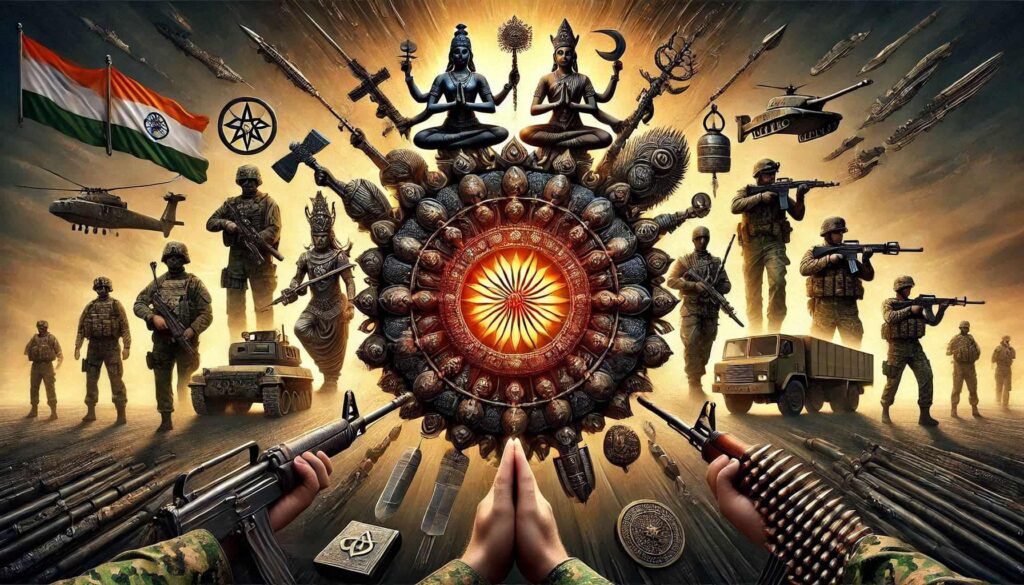100 Sanskrit Names for Defense Business
The defense business revolves around values of strength, protection, strategy, and innovation. Sanskrit, with its profound linguistic heritage and deep symbolic meanings, offers a treasure trove of names perfect for defense-related organizations, technologies, or brands. Each name reflects timeless wisdom, resilience, and invincibility.
Read More About Ritual & Practices
Below is a curated list of 100 Sanskrit names, carefully chosen for defense businesses. These names are categorized for easy understanding and alignment with brand identity.
Names Reflecting Strength and Power

- Shakti (शक्ति) – Power: Symbolizing energy and strength.
- Bala (बल) – Strength: Highlighting force and capability.
- Tejas (तेजस) – Radiance: Denoting brilliance and vigor.
- Vikrama (विक्रम) – Courage: Representing valor and bold actions.
- Prabala (प्रबल) – Strong: Denoting overwhelming force.
- Mahabala (महाबल) – Mighty Strength: Reflecting immense power.
- Agni (अग्नि) – Fire: Symbolizing both destruction and protection.
- Sahasra (सहस्र) – Thousandfold: Denoting vast resources.
- Parakram (पराक्रम) – Heroism: Highlighting extraordinary bravery.
- Indra (इन्द्र) – King of Gods: Representing dominance and authority.
Names Related to Protection and Defense
- Raksha (रक्षा) – Protection: Representing safeguarding and security.
- Suraksha (सुरक्षा) – Security: Emphasizing safety measures.
- Kavacha (कवच) – Armor: Highlighting resilience and protection.
- Varuna (वरुण) – Protector of Waters: Reflecting naval strength.
- Ashvamedha (अश्वमेध) – Victory Sacrifice: Denoting ultimate power.
- Dhanusha (धनुष) – Bow: Representing readiness and precision.
- Trishula (त्रिशूल) – Trident: A symbol of invincibility.
- Ayudha (आयुध) – Weapon: Highlighting tools of defense.
- Drona (द्रोण) – Strategist: Inspired by the legendary military teacher from the Mahabharata.
- Garuda (गरुड) – Eagle King: Representing speed and dominance.
Names Symbolizing Strategy and Wisdom
- Yukti (युक्ति) – Tactic: Highlighting cleverness and planning.
- Niti (नीति) – Policy: Denoting strategic governance.
- Pragya (प्रज्ञा) – Wisdom: Representing foresight and intelligence.
- Samadhi (समाधि) – Focus: Highlighting undeterred determination.
- Chintana (चिन्तन) – Reflection: Encouraging thoughtful planning.
- Viveka (विवेक) – Discernment: Representing clarity and judgment.
- Mantra (मंत्र) – Sacred Formula: A guiding principle for success.
- Artha (अर्थ) – Purpose: Reflecting meaningful objectives.
- Buddhi (बुद्धि) – Intelligence: Representing wisdom and insight.
- Drishti (दृष्टि) – Vision: Highlighting strategic foresight.
Names Inspired by Hindu Deities and Legends
- Shiva (शिव) – Auspicious One: Representing destruction and regeneration.
- Durga (दुर्गा) – Invincible: Symbolizing unbeatable strength.
- Hanuman (हनुमान) – Devotion and Power: Highlighting loyalty and energy.
- Bhima (भीम) – Terrifying Strength: Inspired by the mightiest Pandava.
- Arjuna (अर्जुन) – Heroic Archer: Representing skill and precision.
- Kali (काली) – Time/Destruction: Highlighting transformative energy.
- Rudra (रुद्र) – Fierce Protector: Denoting strength and aggression.
- Indrajit (इन्द्रजित्) – Conqueror of Indra: Highlighting invincibility.
- Varaha (वराह) – Earth Protector: Representing stability.
- Vajra (वज्र) – Thunderbolt: Denoting indestructibility.
Names Representing Invincibility and Fearlessness
- Ajeya (अजेय) – Unconquerable: Representing invulnerability.
- Abhaya (अभय) – Fearless: Highlighting unshakable courage.
- Nirbhaya (निर्भय) – Fearless: Denoting bravery.
- Mahaveer (महावीर) – Great Warrior: Reflecting unmatched valor.
- Durjay (दुर्जय) – Difficult to Defeat: Highlighting resilience.
- Satyavadi (सत्यवादी) – Truthful Warrior: Representing righteous strength.
- Veera (वीर) – Brave: Highlighting heroism and gallantry.
- Sena (सेना) – Army: Denoting collective strength.
- Ananta (अनन्त) – Infinite: Reflecting boundless potential.
- Chakra (चक्र) – Disc: Representing circular defense.
Names for Tactical and Modern Concepts
- Shastra (शस्त्र) – Weaponry: Highlighting advanced tools.
- Rakshaka (रक्षक) – Guardian: Denoting protection and defense.
- Astra (अस्त्र) – Weapon: Symbolizing precision.
- Samagra (समग्र) – Complete: Representing holistic strategy.
- Pratibha (प्रतिभा) – Brilliance: Highlighting ingenuity.
- Sutradhara (सूत्रधार) – Strategist: Representing master planning.
- Kosha (कोश) – Treasure: Denoting resources.
- Dhanurveda (धनुर्वेद) – Art of Archery: Highlighting martial mastery.
- Daksha (दक्ष) – Skilled: Reflecting expertise.
- Samarthya (समर्थ्य) – Capability: Representing competence.
Names Denoting Unity and Resilience
- Sankalpa (संकल्प) – Determination: Highlighting resolve.
- Ekata (एकता) – Unity: Representing collective strength.
- Anvaya (अन्वय) – Connection: Highlighting collaboration.
- Samadhana (समाधान) – Resolution: Denoting problem-solving.
- Vayu (वायु) – Wind: Representing agility and speed.
- Shesha (शेष) – Continuation: Highlighting resilience.
- Ekalavya (एकलव्य) – Disciplined Learner: Representing focus and dedication.
- Trikuta (त्रिकूट) – Three Peaks: Highlighting strength in unity.
- Pralaya (प्रलय) – Dissolution: Denoting ultimate force.
- Darpana (दर्पण) – Mirror: Reflecting clarity and insight.
Closing Names
- Anupama (अनुपम) – Unique: Representing exclusivity.
- Rasa (रस) – Essence: Highlighting core values.
- Shraddha (श्रद्धा) – Faith: Inspiring trust.
- Shanti (शांति) – Peace: Representing calm after victory.
- Prabha (प्रभा) – Light: Highlighting guidance.
- Sampada (संपदा) – Wealth: Denoting abundance.
- Vibhava (विभव) – Splendor: Reflecting excellence.
- Rajata (रजत) – Silver: Denoting resilience.
- Kritanta (कृतान्त) – Finality: Representing decisiveness.
- Divya (दिव्य) – Divine: Highlighting transcendence.
- Rudrani (रुद्राणी) – Fierce Goddess: Representing strength.
- Chaturanga (चतुरंग) – Four Divisions: Symbolizing strategic warfare.
- Jwala (ज्वाला) – Flame: Denoting intense energy.
- Samartha (समर्थ) – Capable: Highlighting effectiveness.
- Shreejaya (श्रीजया) – Auspicious Victory: Representing successful endeavors.
- Darpana (दर्पण) – Mirror: Reflecting clarity.
- Agniveer (अग्निवीर) – Fire Warrior: Highlighting unmatched courage.
- Dhruva (ध्रुव) – Steadfast: Representing focus and strength.
- Taraka (तारक) – Savior: Representing guiding principles.
- Jyoti (ज्योति) – Light: Symbolizing guidance and clarity.
Final Names
- Chandrapala (चंद्रपाल) – Moon Protector: Representing vigilance.
- Rajata (रजत) – Silver: Symbolizing resilience.
- Vidya (विद्या) – Knowledge: Highlighting learning and expertise.
- Taraka (तारक) – Liberator: Denoting deliverance.
- Shrutismriti (श्रुतिस्मृति) – Sacred Knowledge: Highlighting wisdom.
- Bhadraksha (भद्राक्ष) – Auspicious Protector: Representing safety.
- Gandiva (गाण्डीव) – Arjuna’s Bow: Highlighting readiness.
- Harsha (हर्ष) – Joyful Protector: Denoting resilience.
- Moksha (मोक्ष) – Liberation: Highlighting freedom.
- Samriddhi (समृद्धि) – Prosperity: Reflecting growth and success.
This comprehensive list combines cultural depth and strategic alignment for defense businesses, ensuring unique and meaningful branding.


